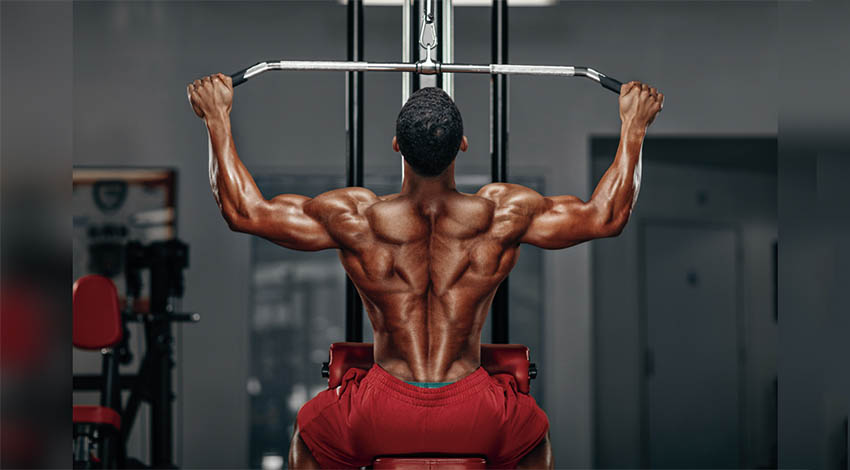The lower back is a crucial component of your overall back strength. Neglecting your lower back will hinder your ability to engage in intensive back workouts effectively. This sentiment holds true for the upper and middle back as well. Consequently, it’s imperative to incorporate specific weighted exercises tailored to each region of your back for a holistic strengthening routine.
A Deep Dive into Lower Back Workouts & Techniques
The lumbar region or the lower back houses the spinal erectors. Not only do they enhance the aesthetic appeal by adding a robust look to the torso from behind, but they also play a pivotal functional role. When engaging in activities that involve lifting heavy weights, primarily with the legs and back, a fortified lumbar region can mitigate injury risks. This muscle area, when trained effectively, safeguards against issues related to vertebral disc displacement and compromised spinal nerve root functionalities. For athletes, a well-developed lower back equates to a sturdy muscular structure that maintains spinal alignment.
For an unyielding lumbar strength, incorporate exercises such as the frontal tilts with a barbell resting on your shoulders (commonly referred to as the “good morning” exercise) and hyperextensions. Deadlifts are also invaluable if you’re aiming for a broad and sturdy back. Here’s a closer look at top-tier exercises for your lower back:
- Hyperextension: An ideal pick for novice athletes or those who have experienced prior lower back issues. This exercise targets the lumbar, gluteal, and hip flexors. It is typically performed using the Roman chair. However, if you’re without this apparatus, a bench press bench can be a substitute, provided you have a partner to anchor your legs. Another alternative is employing a fitness ball. Key points for the exercise on the Roman chair include:
- Position yourself facing down on the chair, securing your feet under the cushion.
- Keep your body linear and either cross your arms in front or position them behind your head. The bench’s edge should be slightly below the groin area.
- Lower your torso as much as comfortably possible without arching your back.
- Slowly return to the starting position, holding for a brief moment. Tips: Ensure controlled movements without momentum. Engage in full-range, deliberate bends and extensions. Avoid rounding the back and practice conscious breathing.
- Stiff Leg Barbell Good Morning: This exercise focuses on the lumbar erectors and offers substantial engagement to the leg muscles, specifically the calf and glutes. You can execute this either seated or standing.
- Deadlift: A foundational exercise, the deadlift involves an extensive range of muscles. Coupled with squats and bench presses, it aids in muscle mass enhancement. It primarily engages the lumbar erectors and the muscles of the thighs, buttocks, back, trapezium, and forearms. Given its intensity, it’s typically performed with heavier weights. Repetition recommendations are:
- Emphasis on lower back development: 10-12 reps.
- Optimal muscle gains: 6-8 reps.
- Strength enhancement in lifting: 3-5 reps.
If you’re inclined towards home-based workouts without weights, there are a plethora of no-weight back exercises available that you can explore and integrate into your routine.
Enhancing Your Middle Back Strength
Training the middle back requires a different approach than other muscle groups. Isolating the muscles in the mid-back during workouts is challenging due to the lack of exercises specifically targeting this area. However, by understanding specific nuances, you can effectively stimulate the lower trapezius and the underlying muscles. Crucial elements that dictate the success of mid-back workouts include your grip style, exercise amplitude, and the weights you use. Of these, ensuring maximum amplitude in every exercise stands paramount. It is essential that during these workouts, your shoulders remain retracted, with the shoulder blades nearly touching. Achieving this proper form is mainly possible with a narrow grip.
While choosing the weight, it’s recommended to opt for slightly lighter than what you might usually prefer. An excessive weight can hinder the full retraction of your shoulders, diverting the strain to the biceps, which would render the exercise ineffective.
For a comprehensive middle back regimen, relying solely on free weights may not suffice. Incorporating specialized gym machines can be advantageous. However, let’s delve into some exercises that use free weights for mid-back development:
- T-Bar Row: Recognized as one of the premier workouts for fortifying the middle back, particularly the lower trapezius and the rhomboids. The focus should be on prolonging peak muscle contraction via an isometric hold. Select a weight that allows for 8-10 clean reps. If your gym lacks specialized equipment, a regular barbell’s end can suffice.
- Bent Over Two-Dumbbell Row: This variation of the dumbbell row targets the mid-back muscles more than the conventional one-arm version. Holding the dumbbells, lean forward so that your upper body is parallel to the floor. As you pull the weights up, ensure your shoulders are retracted and shoulder blades are close. Aim for a 1-2 second pause at the peak of the movement.
- Seated Cable Row: While this exercise is pivotal for the core middle back muscles, many practitioners execute it incorrectly. Ensure maximum stretch at the start of the motion and retract your shoulders fully as you pull. Aim for 10-12 reps across 3 to 4 sets.
Upper Back Workouts Snapshot
Key exercises for chiseling your upper back include:
- Barbell Shrug: Swap those light dumbbells for a heavy barbell. These shrugs can sculpt your trapezius muscles to resemble mountain peaks. Ensure straightforward upward and downward motion without rotating the shoulders.
- Pull-Ups: An unparalleled upper body exercise. Beginners can opt for machine-assisted versions, advancing to traditional pull-ups with practice.
- Seated Cable Row: While many overlook this, it’s essential for an overall balanced back. This exercise also aids in muscle definition.
Beginner’s Full Back Workout Plan
Here’s a foundational back workout tailored for those starting out:
- Bent Over Barbell Row: 3 sets, 6-8 reps.
- Seated Cable Rows: 3 sets, 8-12 reps.
- V-Bar Pulldown: 3 sets, 12 reps.
- Barbell Shrug: 3 sets, 6-8 reps.
- Hyperextensions: 3 sets, 12 reps.
Golden Tips from Dorian Yates for a Robust Back
- Prioritize: Allocate separate days for back workouts, ensuring thorough engagement.
- Intensity: Achieving the maximum intensity even in shorter sessions can yield impressive results.
- Technique Mastery: Target the intended back muscles for each exercise, cherishing the muscle burn as a sign of effective engagement.
Closing Thoughts on Back Workouts
The back, with its expansive muscle group, offers the allure of a powerful silhouette when trained effectively. Implementing the suggested strategies and exercises can sculpt your back muscles to perfection. For accelerated muscle development, some athletes turn to anabolic steroids such as Sustanon, Deca Durabolin, testosterone propionate, and Masteron. These can enhance muscle growth, increase strength, and alleviate post-workout soreness. Always consult with a healthcare professional before considering any supplements or steroids.

